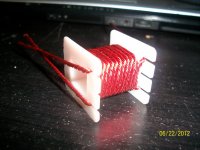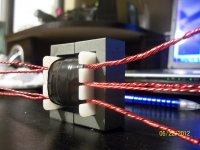Well I had a bunch of cores from several ATX supplies but my sister's basketball had an unfortunate run-in with my workbench and destroyed all my cores when they were knocked onto the concrete floor. I wasn't too happy about that haha ((@
I'm not too worried about the 33A current limit...this smps is gonna be used in my car to power a 250 watt subwoofer system. Since it's audio, it won't draw a continuous 250 watts anyways and even if it did that only comes out to be roughly 21A, so im feeling pretty confident in the ability of the IRF540's to handle it.
Now why would I need to re-adjust the gate resistor?? I know it will improve the switching of the mosfet and such, I've done several experiments at home to see the effect of various gate resistors on switching waveforms, but I don't know WHY it does this...in order to turn the mosfet on, the gate capacitance needs to be charged and for a faster turn on, more current is needed. It would make sense to have a lower resistor value so that more current can pass and therefore theoretically turn it on faster...which is good. So why does increasing the value of the gate resistor slightly cause an improvement in switching?? It's one thing thats puzzled me a little bit -)




